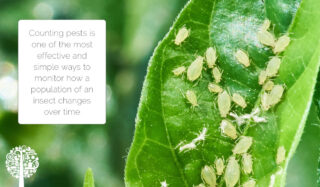Scouting: 7 Guidelines To Build Your Garden Vigilance
The number one practice that will add power to your Integrated Pest Management (IPM) is scouting. I often see professional cultivators fall into a pattern of reactivity instead of proactivity, and it’s a bummer because there are steep consequences from the delayed detection of problems. Usually, you could have avoided the whole thing if you had found the issue earlier. Scouting will stop that vicious cycle!
Record Data

Take notes, keep the notes, and refer to the notes. This could be as simple as a journal or as complex as a database, but you need notes so you can remember exactly what kind of conditions were present when you encountered an issue. Jot down the weather and environment, plant health observations, and pest counts.
Define Your Space
The technical term for this is making a “transect,” but you will need a naming system to define your garden spaces. Divide your garden into sections or give distinct areas silly, unique names. It can be simple, complex, serious, or fun; it should be whatever makes sense for your space. That way, when you take notes, you can communicate where you find the issues.
Macro to Micro

A general rule for crop health observation is to go from big to small. Observe the transect area as a whole, and then observe on a plant level. Scan areas for differences; our brains are very good at doing this comparative work. Look for color, size, and shape differences. Scan across the entire crop, the transect area, or the entire plant from the top to the crown and roots. Magnification is another powerful tool for scouting. A hand lens and/or dissecting microscope are crucial to getting your eyes onto an even smaller level of plant observation.
Randomize Plant Selection
Randomly select the plants to scout individually. Most of us don’t have the luxury of looking at every plant in our garden, so you will have to choose a representative set of plants to look at more closely. Want to get fancy and eliminate bias from your plant selection? Have a standard numbering system for your plants (ex., the southeast most plant is always 1, and you always count from east to west), then use a random number generator to select a specific plant. You can find many free ones online. Then examine randomly selected plants to put through a more thorough plant-level scouting protocol.
Monitor Pest Populations

Counting pests is one of the most effective and simple ways to monitor how a population of an insect changes over time. There are several methods for insect counting. You could use a beat cloth, paintbrush, and tray to shake/brush loose insects and collect them for identification. Leaf samples can be taken, and insects counted under a dissecting microscope. You can use a hand lens to identify insects in the field. Sticky traps are another tool to help you identify and measure flying insect populations. After you decide which pest counting methods you want to use, conduct pest counts on your randomly selected plants, and record your numbers so you can use them for future comparison.
Pest & Disease Identification

Know Your Enemy. An organism’s life cycle will always provide clues for prevention, detection, and identification. Knowing an organism’s parameters to thrive and unique identifiers of its life cycle will take your scouting to the next level.
For instance, with the dreaded powdery mildew, the temperature range for infection is between 68 to 77°F, and relative humidity between 40 to 100% is sufficient for the spores to germinate. Diffused or low light will also favor powdery mildew development. These life cycle parameters are why air movement in the lower canopy and good pruning practices are necessary to protect susceptible crop types. If you can’t keep it hot and dry, you must watch for those little infection spots to pop up.
Unique life cycle observations can provide conclusive details for identifying a pest. The broad mite, for example, has unique eggs. They are oblong and covered in polyps. Also, the males will carry around the dormant females on their back, which is a dispersal mechanism for this pest, but also a BRILLIANT clue that you are looking at the infamous broad mite.
The Observation Lens
Develop an observation habit when caring for your garden. Always be scouting. Always be vigilant. Watering, moisture monitoring, pruning, and trellising are all touchpoints with your plants and moments you can use to examine plant health. If you work with a team and everyone is in this mindset, you have several eyeballs in the garden instead of just one person and their weekly scouting protocol. Give the freedom to team members to capture pictures or videos of symptoms or flag out areas that need further inspection.

Scouting is an art; not all the tools or methods will be needed for every situation. Scouting practices are vast and many, specific to pressures, crop types, climate, and how a farm/garden operates. These guidelines inform the mindset needed to create an effective scouting practice. So, don’t be intimidated, and don’t think of scouting as a rigid, uber-technical thing. Instead, think of scouting as learning the story of your garden ecosystem and be comforted that you will navigate the challenges with a solid foundation of facts.




